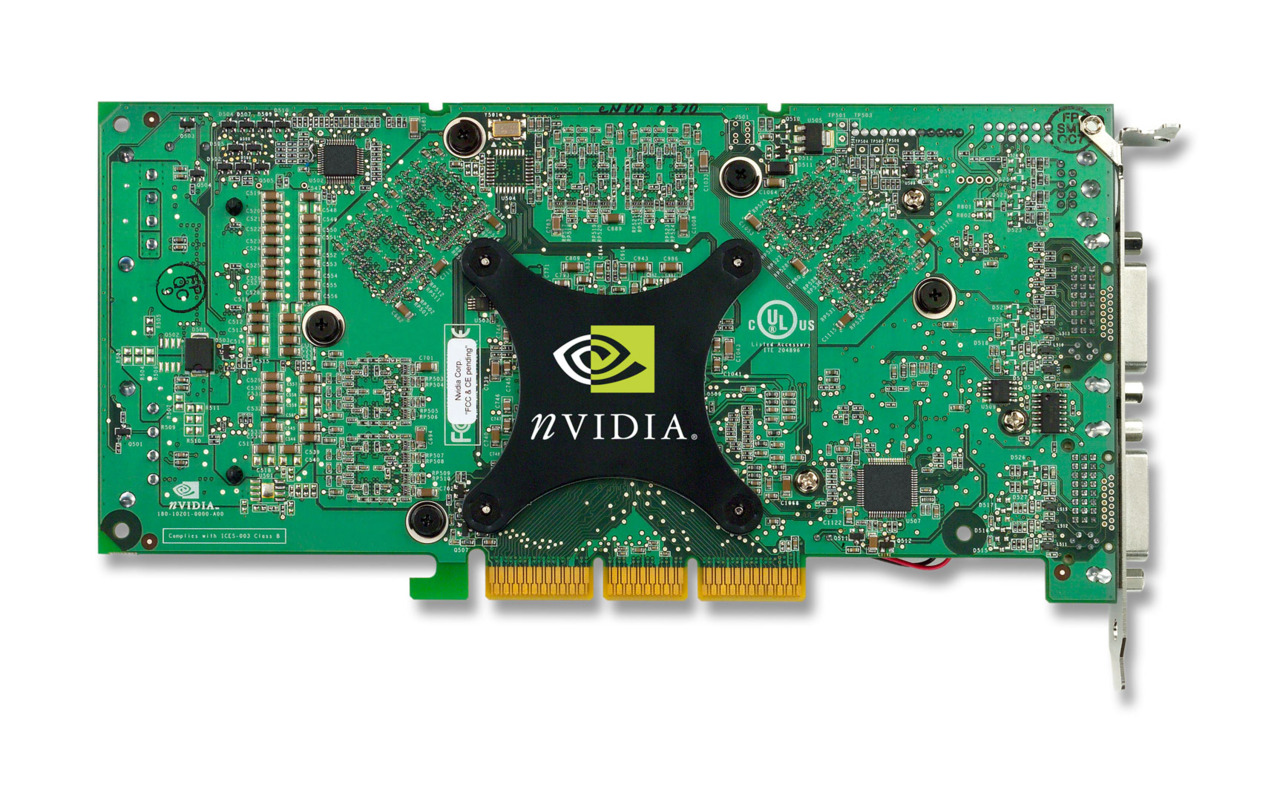Nvidia GeForce 6800 Ultra Hands-On Preview
We take Nvidia's new flagship video card for a test drive. Is it fast enough to retake the performance crown from ATI's Radeon lineup? What new features will be made available to developers? Read our hands-on preview for the scoop.
Design by Marty Smith
Nvidia opens the next-generation graphics card race with today's official announcement of the Nvidia GeForce 6 GPU series. Code-named NV40, the GeForce 6 GPU family will soon replace Nvidia's current NV3x-based GeForce FX line of graphics processing units. And not a moment too soon, many will add.
It's no secret that many consider ATI the winner of the previous architecture cycle, in large part due to the strength of the Radeon 9700/9800 series design, but also due to production delays and a handful of miscalculated design decisions on the part of Nvidia.

ATI was able to get the Radeon 9700 to market roughly six months ahead of the GeForce FX because Nvidia tried to adopt the then relatively new 0.13-micron manufacturing process. Usually a move to a smaller manufacturing process results in smaller chip dies and higher potential clock speeds, but Nvidia encountered problems with the move that resulted in a significant shipping delay. ATI, on the other hand, used the less efficient but proven 0.15-micron process to get to market quickly.
When the first GeForce FX did ship, it only featured a 128-bit memory interface, which required Nvidia card manufacturers to use faster, more expensive memory just to get close to the memory bandwidth offered by ATI's 256-bit memory interface. Nvidia did correct the issue by including a 256-bit memory interface with the GeForce FX 5900 release, but another crisis emerged when Valve's Gabe Newell openly criticized the GeForce FX's full-precision floating point performance under Pixel Shader 2.0.
Nvidia smoothed over the incident by acknowledging that games needed special optimizations for the GeForce FX and indicating that the next driver release would have optimizations for Valve's Half-Life 2, but Nvidia still took a significant blow in the eyes of consumers.
Today, Half-Life 2 still has yet to reach gold status, but it looks like Nvidia finally has an answer to the performance question with the announcement of the new GeForce 6 line of GPUs. Nvidia showcased the GeForce 6800 at its Editors' Day 2004 event just over a week ago. Company officials presented details of the new GPU along with several impressive technology demonstrations.
| GeForce 6800 Ultra | Radeon 9800XT | |
| Transistors | 222 million | 115 million |
| Core Clock | 400MHz | 412MHz |
| Pixel Pipelines | 16 | 8 |
| Vertex Units | 6 | 4 |
| Memory Bus | 256-bit | 256-bit |
| Memory Clock | 550MHz (1100MHz effective) | 365MHz (730MHz effective) |
As you can see, the GeForce 6800 weighs in with a hefty 222 million transistors, almost double that of the Radeon 9800XT's 115M. To offer a little CPU comparison, Intel's Prescott Pentium 4 processor sports 125M transistors, and AMD's Athlon 64 has a 105.9M count. Manufactured on IBM's 0.13-micron process, the GeForce 6800 Ultra will ship with a 400MHz clock speed.
The extra complexity is necessary since Nvidia has outfitted the GeForce 6800 Ultra with 16 pixel pipelines and six vertex units. In comparison, the ATI Radeon 9800XT has eight pixel pipelines and four vertex units. Running at a 400MHz clock speed, the GeForce 6800 Ultra's theoretical peak fill rate will be a massive 6400 Mpixels per second.
Note that we're only talking about the 6800 Ultra version here. Nvidia plans to release two different GeForce 6800 versions to target different consumer markets. Both cards will support the same feature set but will vary in performance levels and memory configurations. The GeForce 6800 Ultra will have 16 pipelines, 400MHz core clock, 256MB of memory, two four-pin Molex power connectors, and an estimated street price of $499. The regular GeForce 6800 will have 12 pipelines, 128MB of memory, a single Molex connector, and a $299 price tag. Nvidia has yet to announce clock speeds for the regular 6800 GPU. Both the Ultra and non-Ultra versions should hit store shelves near the end of May.
The heat sink and fan unit on the Ultra reference card is a double-height solution that will preclude the use of the top-most PCI slot directly below the video card. It will also be difficult, if not impossible, to fit one into a small form factor system (SFF) such as a Shuttle box. For what it's worth, Nvidia's 480W power supply recommendation for the GeForce 6800 Ultra likely ruled out your SFF system already. The non-Ultra 6800 card will be a one-slot solution, and the power supply recommendation has yet to be announced.
Our reference GeForce 6800 Ultra card has 256MB of GDDR3 (graphics double data rate-3) memory. GDDR3 is a third generation of double data rate memory type, designed for graphics and other high-bandwidth applications. GDDR3 memory has a smaller form factor, runs at a much lower voltage than DDR2, and is able to hit much higher clock speeds. The memory on the Ultra runs along at a smoking 550MHz, an effective 1100MHz when you take the double data rate into account.
What's really special about the GeForce 6800 is the support for Microsoft DirectX 9.0 Pixel Shader 3.0 and Vertex Shader 3.0. The advanced support will allow developers to write longer and more complex shader programs to achieve better effects such as subsurface scattering and detailed real-time lighting without the debilitating performance hit today's video cards would take if they attempted such feats.
We watched the GeForce 6800 Ultra render a mermaid swimming in place just below the surface of the ocean in Nvidia's Nalu demo. The first immediately noticeable detail about Nalu was that she had individual strands of hair, 10,000 in all, swaying and physically reacting to the environment in real time. The volumetrically lit hair also accounted for the reduction of light as it passed through the hair with the top surface layers reflecting the majority of the light. Shaders added shimmering iridescent scales to her body that changed color as she moved and as light angles changed. According to Nvidia, the demo would only be able to run at 1 to 2 frames per second on a GeForce FX 5950 Ultra.
The GeForce 6800's Vertex Shader 3.0 support also enables real-time displacement mapping, which allows for actual vertex manipulation. In the past, developers had to create the illusion of depth with shader tricks like bump-mapping, but displacement mapping allows developers to move around geometry to create real deformations capable of light interactions, including the ability to cast and receive shadows.
Other features include native 32-bit floating point precision throughout the rendering pipeline and high dynamic-range rendering, which increases precision in shading, blending, filtering, and texturing operations for more realistic images. Nvidia has also added support for four-sample rotated grid antialiasing.
Gamers won't see the GeForce 6800 Ultra's Shader Model 3.0 (Pixel Shader 3.0 + Vertex Shader 3.0) features in action until developers start releasing games that fully utilize the card. Fortunately, however, the GeForce 6800 Ultra still offers exceptional performance in current games, thanks to its 16 pixel pipelines and improved shader architecture.
We tested our reference GeForce 6800 Ultra card on an Intel 3.4GHz Northwood processor with an ASUS P4C800-E Deluxe motherboard and 1GB (512MB x 2) of Samsung CL3 memory in a dual channel configuration.
Yes, those 3DMark03 scores are correct. While the current generation's high-end video cards all top out in the 6,000-7,000 range, the GeForce 6800 Ultra smashes through the barrier with an impressive 12,228 3DMarks.
The GeForce 6800 Ultra's 3197 Mtexels/s single-texture fill-rate result seems low, but according to Nvidia, this result is due to "frame buffer bandwidth limitations, not architectural limitations, as this test performs alpha blending." The 6171 Mtexels/s score in the multi-texturing test comes much closer to the Ultra's theoretical 6400 Mtexels/s peak.
The results of the vertex shader tests also seem to confirm the Ultra's 6:4 vertex unit advantage over the Radeon 9800XT. We also see the Ultra's vertex shader advantage demonstrated in the ragtroll test where several trolls fall off a ledge and fall onto staircases and other surfaces below--the CPU handles the ragdoll physics calculations, while the video card handles the vertex work.
The GeForce 6800 Ultra is entirely CPU bound in Unreal Tournament 2004 without antialiasing or anisotropic filtering enabled; the CPU simply can't process its load fast enough to really tax the Ultra. The game only starts to present a challenge at 1600x1200 with 4x antialiasing and 8x anisotropic filtering enabled, but, amazingly, the frame rate hit is less than 5 percent. Halo: Combat Evolved for the PC doesn't support antialiasing, but the DX9 game is challenging enough for today's video cards. The GeForce 6800 Ultra actually makes the game very playable at 1600x1200.
The Nvidia GeForce 6800 is truly a next-generation part offering dramatic performance increases across the board in today's games as well as support for forward-looking technology such as Microsoft DirectX 9.0 Shader Model 3.0 for future games. Keep in mind that ATI will announce its next-generation graphics cards in the coming weeks, and we won't be able to declare a winner until actual SM 3.0 games become available. Several high-profile games in the works include Vampire: Bloodlines, S.T.A.L.K.E.R.: Shadows of Chernobyl, and The Lord of the Rings: The Battle for Middle-Earth.
Got a news tip or want to contact us directly? Email news@gamespot.com





Join the conversation